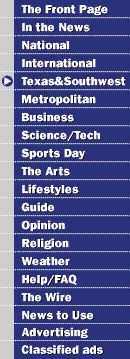|
03/01/93
Bureau had trained months for raid
By Tracy Everbach / The Dallas Morning News
For eight months, federal firearms agents had trained in secret for a surprise raid on a highly armed and dangerous cult outside Waco.
But the plan backfired Sunday when the agents walked into an unexpected barrage of high-powered gunfire.
The result was the bloodiest day in the 20-year history of the U.S.
Bureau of Alcohol, Tobacco and Firearms: four agents dead and 15 wounded. The agency did not disclose the victims' names, saying it first had to notify their families.
Bureau agents had been investigating the heavily armed Branch Davidian cult and its self-appointed messiah, Vernon Howell, for eight months. The bureau had information that the group was stockpiling explosives and illegal machine guns, said Jack Killorin, a bureau spokesman in Washington.
A group of highly trained bureau agents repeatedly practiced raids.
They were members of units known as special response teams, assigned to secure locations and prisoners and handle sniper fire. The agents tried to anticipate the weaponry they might face in raiding the Davidians. Most of them worked in the Dallas and New Orleans field offices.
"This was planned and drilled for months before it was carried out," Mr. Killorin said Sunday. "We knew it was an armed and dangerous encampment in close proximity to a major population."
At least one agent knew firsthand what kind of illegal artillery existed at the Davidians' complex, along a county road 10 miles east of Waco. That agent had been inside several times in an undercover capacity, said Mr. Killorin, who declined to specify the nature of that operation.
Sunday, agents were ready to make their move. They planned to execute a search warrant-which would allow them to search the premises for illegal weapons and explosives and seize what they found -- and an arrest warrant for Mr. Howell on charges of illegally possessing machine guns.
But as more than 100 agents charged the complex on flatbed trucks and in helicopters, they were showered with gunfire, some of it from high-caliber machine guns.
"At least some of the reports are that agents were wounded with .50-caliber weapons with bullets a half-inch in diameter," Mr. Killorin said.
Agents wore body armor, helmets and shields resistant to high-powered rifle fire. The Davidians' .50-caliber guns, generally used as anti-vehicle weapons, easily could have shot through the agents' protective gear, Mr. Killorin said.
In dramatic footage filmed by television crews covering the raid, a lone agent could be seen waiting on the roof after three agents entered a window. A few seconds later, bullets plow through the wall from inside the building as the agent scrambles to descend a ladder. There was no word on his condition.
The agency will scrutinize the decision to raid the complex Sunday to determine whether it was handled properly and to examine how better to prepare for similar situations in the future, Mr. Killorin said.
"There are lots of questions," he said.
Sunday's raid came one day after the Davidians' Sabbath. It also
came one day after the Waco Tribune-Herald published the first installment of a seven-part series alleging that the group was gathering illegal firearms and that Mr. Howell was sexually assaulting minors. He denied those charges.
Mr. Killorin defended the bureau's decision to proceed with the raid despite the publicity about the group.
"Law enforcement officers' lives are on the line every day in America," he said. "We're looking at an unusual group that was stockpiling weapons and had shown their willingness to use them. What were we to do, walk away and let the people of Waco worry about it? I don't think that's an acceptable alternative."p>
The Davidians "were a threat to the community. The action was planned to enforce the law. It was known from the beginning it would be a dangerous and touchy situation."
Several times, federal agents have been in such situations with extremist groups.
"The past decade or so has been spotted by gunbattles between federal officers and religious cults or right-wing, Nazi groups," Mr. Killorin said, "all with a leader who purports to be in touch with a godhead and says Armageddon is around the corner and that you need to take up arms against the undesirables."
Those incidents include the following:
In August in Idaho, a U.S. marshal was killed in a shootout at a mountain cabin with members of the Christian Identity Movement, a group espousing white supremacist beliefs. Six marshals were on a reconnaissance patrol looking for Randy Weaver, a devotee of the movement who was a federal fugitive, when the shooting occurred. Also killed during the shootout and ensuing 11-day standoff were Mr. Weaver's wife and 14-year-old son, who were inside the cabin.
In January 1988, a 13-day standoff in Marion, Utah, between a polygamist clan and law enforcement officers ended in a shootout in which a state police officer was killed and the group's ringleader, a suspect in the bombing of a Mormon chapel, was wounded. An FBI agent was shot in the chest but saved by a bulletproof vest.
In April 1985, ATF and FBI agents exchanged gunfire in Arkansas with members of a heavily armed survivalist and white supremacist organization known as the Covenant, the Sword and the Arm of the Lord. The agents had gone to the group's encampment in the Ozark Mountains to arrest its leader, James Ellison, on firearms charges.
In February 1983, two U.S. marshals were killed in a North Dakota shootout with members of Posse Comitatus, a militant tax protest group. Five months later, an Arkansas county sheriff died in a shootout that also killed Gordon Kahl, the man sought for killing the marshals.
The bureau traces its roots to 1791 and Treasury Secretary Alexander Hamilton's tax on "spirits,' which led to the Whisky Rebellion in 1794. The agency's most promiment moments came in the 1920s and '30s, when it was known as the Bureau on Prohibition and had an agent named Eliot Ness working out of its Chicago office.
The bureau gained jurisdiction over firearms laws in 1942. In 1972, it gained full bureau status within the Treasury Department as the Bureau of Alcohol, Tobacco and Firearms, empowered to investigate crimes and enforce laws involving firearms, explosives and arson. It also ensures that businesses dealing in alcohol, tobacco and firearms comply with federal regulations and pay required taxes.
The bureau has about 2,200 agents, 21 field offices and five regional offices.
The Associated Press and New York Times News Service contributed to this report.
|


![]()



